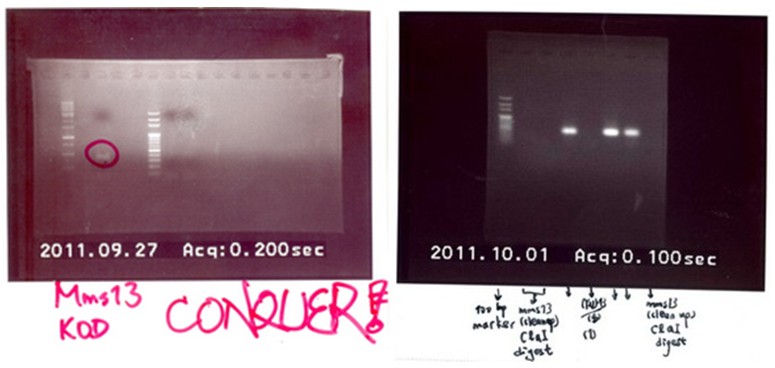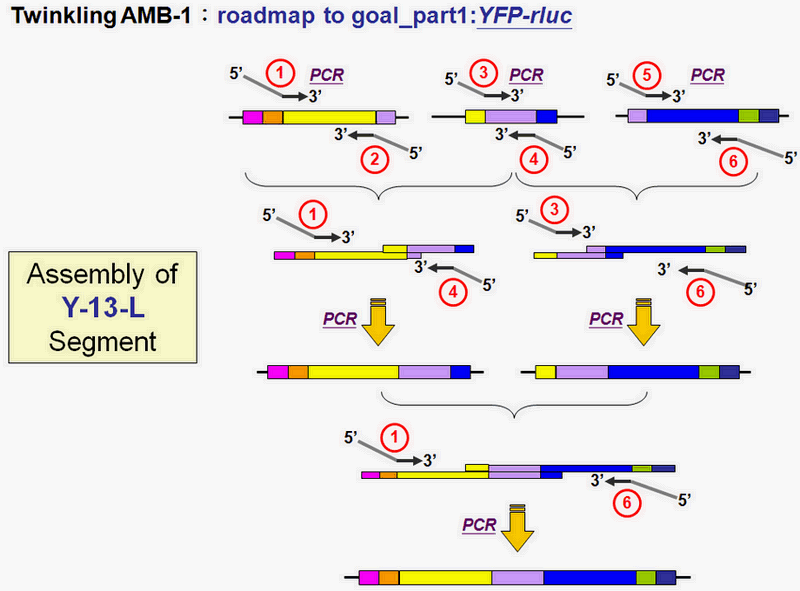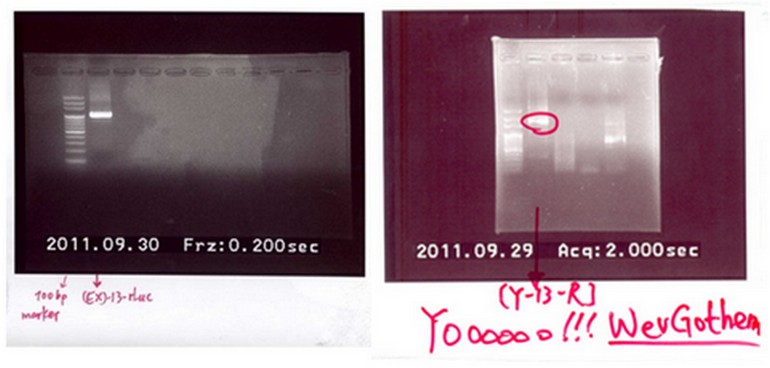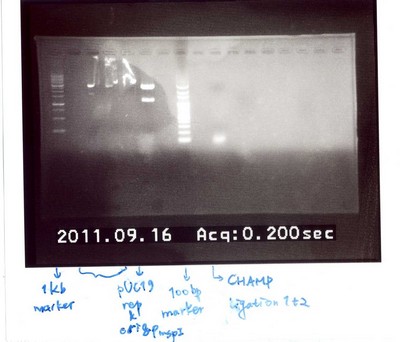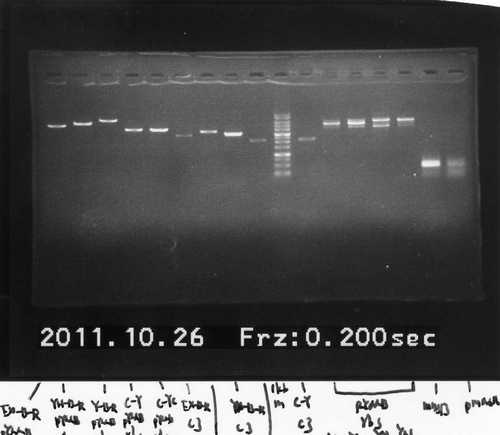Team:NYMU-Taipei/results/optomagnetic-design1
From 2011.igem.org
CHIACHENHSU (Talk | contribs) |
(→Constructs and Experimental Results) |
||
| (106 intermediate revisions not shown) | |||
| Line 1: | Line 1: | ||
{{:Team:NYMU-Taipei/Templates/Header/menubar}} | {{:Team:NYMU-Taipei/Templates/Header/menubar}} | ||
| - | ==<font size=5><font color=crimson> | + | |
| + | |||
| + | |||
| + | |||
| + | |||
| + | |||
| + | |||
| + | |||
| + | =='''<font size=5><font color=crimson>Constructs and Experimental Results</font>'''== | ||
<font size=3> | <font size=3> | ||
| - | |||
| - | + | We now follow the steps we construct our design to examine and illustrate what we have done so far. | |
| + | <font color=deeppink> The total parts we constructed and their detailed information are recorded in our '''partsregistry pages'''.</font> | ||
| - | [[Image: | + | [[Image:total_NYMU.png|frame|center|none|Fig. 1:This is the total constructs of our optomagnetic design, the notation for each columns with different colors can be seen in the following paragraphs.]] |
| - | + | '''<font size=4><font color=green>The Beginning</font>''' | |
| - | + | As soon as we have the AMB-1 bacterial colony, we do the AMB-1 colony PCR to get the Mms13's DNA sequences as our parts to do the following steps. | |
| - | + | The correcterized gel electrophoresis result is shown below.(See Figure 2) The detail of <font color=deeppink>part Mms13's</font> information: [http://partsregistry.org/wiki/index.php?title=Part:BBa_K624005 BBa_K624005]. | |
| - | [[Image: | + | [[Image:13_NYMU.png|frame|center|none|Fig. 2:The correcterized gel electrophoresis result of Mms13.]] |
| + | |||
| + | '''<font size=4><font color=green>Construct Mms13</font>''' | ||
| + | |||
| + | After having the fundamental material of Mms13, we did the next step of our construct(See Figure 3). | ||
| + | |||
| + | [[Image:y-13-r_NYMU.png|frame|center|none|Fig. 3:We used several steps of recombinant PCR to assemble (1)mms13-rLuc; (2)YN-mms13-rLuc; (3)Y-mms13-rLuc, why we chose recombinant PCR is because of two reasons: (1) the less time it took and (2)we found better precision in recombinant PCR than in ligation process.]] | ||
| + | |||
| + | The characterized and checked results shown in Figure 4. | ||
| + | [[Image:1_NYMU.png|frame|center|none|Fig. 4:Checked YFP-Mms13-rluc part.]] | ||
| + | |||
| + | For parts <font color=deeppink>mms13-rLuc</font>, links to [http://partsregistry.org/wiki/index.php?title=Part:BBa_K624007 BBa_K624007]; <font color=deeppink>YN-mms13-rLuc</font>, links to [http://partsregistry.org/wiki/index.php?title=Part:BBa_K624008 BBa_K624008]; <font color=deeppink>EYFP-mms13-rLuc fusion</font>, links to [http://partsregistry.org/wiki/index.php?title=Part:BBa_K624006 BBa_K624006]. | ||
| + | |||
| + | '''<font size=4><font color=green>Construct CHAMP Design</font>''' | ||
| + | |||
| + | As for the CHAMP part, we use ligation process to get the whole sequences of CHAMP peptides. However, we still use the recombinant PCR procedure to anchor either YC or YFP in our process. | ||
| + | Several electrophoresis results for CHAMP constructs are shown below. | ||
| + | |||
| + | [[Image:champ_NYMU.png|frame|Fig. 6:YFP with CHAMP Ligation sequences' C-terminus by recombinant PCR, and its associated parts-(1)<font color=deeppink>CHAMP-YC</font>, links to [http://partsregistry.org/wiki/index.php?title=Part:BBa_K624026 BBa_K624026], (2)<font color=deeppink>CHAMP-EYFP</font>, links to [http://partsregistry.org/wiki/index.php?title=Part:BBa_K624025 BBa_K624025].]] | ||
| + | |||
| + | [[Image:champ_NYMU.png|frame|none|Fig. 5:Total <font color=deeppink>CHAMP Ligation</font>, and its part links to [http://partsregistry.org/wiki/index.php?title=Part:BBa_K624010 BBa_K624010].]] | ||
| + | |||
| + | |||
| + | |||
| + | '''<font size=4><font color=green>Whole Construct and Experimental Results</font>''' | ||
| + | |||
| + | After we have both materials of Mms13's construction and CHAMP peptides' construction, we use ligation procedure to fulfill six constructs we design in our optomagnetic-design. | ||
| + | |||
| + | [[Image: c1_NYMU.png|frame|none|Fig. 7: The main design construct. Ori is the origin of replication of AMB-1. Pmsp1 is the promoter for AMB-1.]] | ||
| + | |||
| + | The correlated part of construct in Fig. 7 is <font color=deeppink>pYMB essentials+[YN-13-R]+[YC-CHAMP]</font>, links to [http://partsregistry.org/wiki/index.php?title=Part:BBa_K624018 BBa_K624018]. | ||
| + | |||
| + | [[Image: c2_NYMU.png|frame|none|Fig. 8: A construct without YC on the CHAMP is our negative control in our design. It would not light up no matter there is magnetic field applied or not.]] | ||
| + | |||
| + | The related part of construct in Fig. 8 is <font color=deeppink>pYMB essentials+[YN-13-R]</font>, links to [http://partsregistry.org/wiki/index.php?title=Part:BBa_K624024 BBa_K624024]. | ||
| + | |||
| + | [[Image: c3_NYMU.png|frame|none|Fig. 9:. We design this construct with the whole YFP on the N-terminus of Mms13 and the CHAMP design to induce the BRET phenomenon. We suppose that with the CHMAP design, the construct will light up only when magnetic force is applied.]] | ||
| + | |||
| + | Part related to construct in Fig. 9 is <font color=deeppink>pYMB essentials+[Y-13-R]+[CHAMP]</font>, links to [http://partsregistry.org/wiki/index.php?title=Part:BBa_K624017 BBa_K624017]. | ||
| + | |||
| + | [[Image: c4_NYMU.png|frame|none|Fig. 10: This design is constructed with the whole YFP on the N-terminus of Mms13 but “without” the CHAMP design. The construct should be a positive control with constant light no matter whether force is applied or not.]] | ||
| + | |||
| + | Correlated part to construct in Fig. 10 is <font color=deeppink>pYMB essentials+[Y-13-R]</font>, links to [http://partsregistry.org/wiki/index.php?title=Part:BBa_K624023 BBa_K624023]. | ||
| + | |||
| + | [[Image: c5_NYMU.png|frame|none|Fig. 11: The design construct is similar with construct in Fig. 5. Why we construct this design with the whole YFP on the C-terminus of the CHAMP design instead of Mms13’s N-terminus is that we try to avoid the interferences of DNA transformation with sequences added in front of the natural construct. The construct is supposed to light up when force pull the Mms13 and turn off if no magnetic field is applied.]] | ||
| + | |||
| + | The related part to Fig. 11's construct is <font color=deeppink>pYMB essentials+[13-R]+[Y-CHAMP]</font>, links to [http://partsregistry.org/wiki/index.php?title=Part:BBa_K624019 BBa_K624019]. | ||
| + | |||
| + | [[Image: c6_NYMU.png|frame|none|Fig. 12: In this last construct, only r-luciferase anchored on Mms13’s C-terminus. It will light up in yellow light (with 580 nm wavelength) due to the luciferase reaction, instead of the green light induced from BRET phenomenon (540 nm wavelength).]] | ||
</font> | </font> | ||
| + | |||
| + | Part related to construct in Fig. 12 is <font color=deeppink>pYMB essentials+[13-R]</font>, links to [http://partsregistry.org/wiki/index.php?title=Part:BBa_K624020 BBa_K624020]. | ||
| + | |||
| + | [[Image: c7_NYMU.png|frame|none|Fig. 13: Total six constructs after characterization.]] | ||
| + | |||
| + | '''<font size=4><font color=green>Trial and Error</font>''' | ||
| + | |||
| + | [[Image: 110.png|frame|none|Fig. 13: The errors we met when trying to ligate 9 divided synthesized sections of Mms13. We solved this problem by using colony PCR to get the gene sequences of Mms13.]] | ||
Latest revision as of 22:33, 28 October 2011

Constructs and Experimental Results
We now follow the steps we construct our design to examine and illustrate what we have done so far. The total parts we constructed and their detailed information are recorded in our partsregistry pages.
The Beginning
As soon as we have the AMB-1 bacterial colony, we do the AMB-1 colony PCR to get the Mms13's DNA sequences as our parts to do the following steps.
The correcterized gel electrophoresis result is shown below.(See Figure 2) The detail of part Mms13's information: [http://partsregistry.org/wiki/index.php?title=Part:BBa_K624005 BBa_K624005].
Construct Mms13
After having the fundamental material of Mms13, we did the next step of our construct(See Figure 3).
The characterized and checked results shown in Figure 4.
For parts mms13-rLuc, links to [http://partsregistry.org/wiki/index.php?title=Part:BBa_K624007 BBa_K624007]; YN-mms13-rLuc, links to [http://partsregistry.org/wiki/index.php?title=Part:BBa_K624008 BBa_K624008]; EYFP-mms13-rLuc fusion, links to [http://partsregistry.org/wiki/index.php?title=Part:BBa_K624006 BBa_K624006].
Construct CHAMP Design
As for the CHAMP part, we use ligation process to get the whole sequences of CHAMP peptides. However, we still use the recombinant PCR procedure to anchor either YC or YFP in our process. Several electrophoresis results for CHAMP constructs are shown below.
Whole Construct and Experimental Results
After we have both materials of Mms13's construction and CHAMP peptides' construction, we use ligation procedure to fulfill six constructs we design in our optomagnetic-design.
The correlated part of construct in Fig. 7 is pYMB essentials+[YN-13-R]+[YC-CHAMP], links to [http://partsregistry.org/wiki/index.php?title=Part:BBa_K624018 BBa_K624018].
The related part of construct in Fig. 8 is pYMB essentials+[YN-13-R], links to [http://partsregistry.org/wiki/index.php?title=Part:BBa_K624024 BBa_K624024].
Part related to construct in Fig. 9 is pYMB essentials+[Y-13-R]+[CHAMP], links to [http://partsregistry.org/wiki/index.php?title=Part:BBa_K624017 BBa_K624017].
Correlated part to construct in Fig. 10 is pYMB essentials+[Y-13-R], links to [http://partsregistry.org/wiki/index.php?title=Part:BBa_K624023 BBa_K624023].

The related part to Fig. 11's construct is pYMB essentials+[13-R]+[Y-CHAMP], links to [http://partsregistry.org/wiki/index.php?title=Part:BBa_K624019 BBa_K624019].
Part related to construct in Fig. 12 is pYMB essentials+[13-R], links to [http://partsregistry.org/wiki/index.php?title=Part:BBa_K624020 BBa_K624020].
Trial and Error
 "
"







